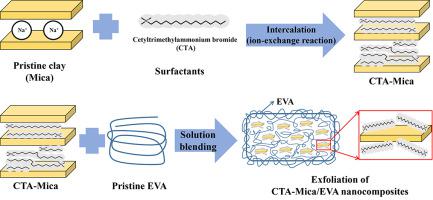当前位置:
X-MOL 学术
›
Appl. Clay. Sci.
›
论文详情
Our official English website, www.x-mol.net, welcomes your feedback! (Note: you will need to create a separate account there.)
Effect of organo-smectite clays on the mechanical properties and thermal stability of EVA nanocomposites
Applied Clay Science ( IF 5.6 ) Pub Date : 2020-10-01 , DOI: 10.1016/j.clay.2020.105750 Hyeon-Ju Ryu , Nguyen Thu Hang , Ji-Hee Lee , J. Yoon Choi , Goeun Choi , Jin-Ho Choy
Applied Clay Science ( IF 5.6 ) Pub Date : 2020-10-01 , DOI: 10.1016/j.clay.2020.105750 Hyeon-Ju Ryu , Nguyen Thu Hang , Ji-Hee Lee , J. Yoon Choi , Goeun Choi , Jin-Ho Choy

|
Abstract Ethylene vinyl acetate (EVA) nanocomposites containing hydrophobic organo-clays were prepared by a solution blending method to investigate the role of organic modifiers stabilized in the interlayer space of host clays on the thermal stability and mechanical strength of EVA. The smectite clays such as Mt. (Na-montmorillonite), Mica (Na‑fluorine mica), and Ht (Na-hectorite) were used as the host with different particle sizes, but hydrophobically modified by intercalating the long chained alkylammonium surfactants like cetyltrimethylammonium (CTA) bromide, and dimethyldistearylammonium (DMDSA) bromide to form organo-clays. Thus, prepared organo-clays were dispersed homogeneously in a toluene solution of EVA, and then the toluene was evaporated to obtain the organo-clay/EVA nanocomposites. According to the powder XRD analyses for all the nanocomposites, the CTA-clays were better exfoliated and dispersed in EVA matrix than the DMDSA-ones. Among three CTA-clay/EVA nanocomposites, the CTA-Mica/EVA one was determined to be the best in terms of thermal stability compared to the other two nanocomposites, CTA-Mt/EVA and CTA-Ht/EVA. The thermal stability of the CTA-Mica/EVA nanocomposite was significantly improved by ~38 °C, compared to that of the pristine EVA. Upon increasing the CTA-Mica loading concentration up to 12 wt% in EVA matrix, the Young's modulus and tensile strength of the EVA nanocomposites were increased up to 54% in maximum. It is, therefore, suggested that the CTA-Mica is a potential nanofiller for enhancing the thermal stability and mechanical properties of EVA.
中文翻译:

有机蒙脱石粘土对EVA纳米复合材料力学性能和热稳定性的影响
摘要 采用溶液共混法制备含有疏水有机粘土的乙烯醋酸乙烯酯(EVA)纳米复合材料,研究稳定在主体粘土层间空间中的有机改性剂对EVA热稳定性和机械强度的影响。蒙脱石粘土,如 Mt。(Na-蒙脱石)、云母(Na-氟云母)和 Ht(Na-锂蒙脱石)用作具有不同粒径的主体,但通过插入长链烷基铵表面活性剂(如溴化十六烷基三甲基铵 (CTA) 和二甲基二硬脂基铵)进行疏水改性(DMDSA) 溴化物形成有机粘土。因此,将制备的有机粘土均匀地分散在 EVA 的甲苯溶液中,然后蒸发甲苯以获得有机粘土 / EVA 纳米复合材料。根据所有纳米复合材料的粉末 XRD 分析,CTA 粘土比 DMDSA 粘土更好地剥离和分散在 EVA 基质中。在三种 CTA-粘土/EVA 纳米复合材料中,与其他两种纳米复合材料 CTA-Mt/EVA 和 CTA-Ht/EVA 相比,CTA-云母/EVA 一种被确定在热稳定性方面是最好的。与原始 EVA 相比,CTA-Mica/EVA 纳米复合材料的热稳定性显着提高了约 38°C。将 EVA 基体中 CTA-云母负载浓度增加至 12 wt% 后,EVA 纳米复合材料的杨氏模量和拉伸强度最大增加至 54%。因此,表明 CTA-Mica 是一种潜在的纳米填料,可提高 EVA 的热稳定性和机械性能。CTA 粘土比 DMDSA 粘土更好地剥离和分散在 EVA 基质中。在三种 CTA-粘土/EVA 纳米复合材料中,与其他两种纳米复合材料 CTA-Mt/EVA 和 CTA-Ht/EVA 相比,CTA-云母/EVA 一种被确定在热稳定性方面是最好的。与原始 EVA 相比,CTA-Mica/EVA 纳米复合材料的热稳定性显着提高了约 38°C。将 EVA 基体中 CTA-云母负载浓度增加至 12 wt% 后,EVA 纳米复合材料的杨氏模量和拉伸强度最大增加至 54%。因此,表明 CTA-Mica 是一种潜在的纳米填料,可提高 EVA 的热稳定性和机械性能。CTA 粘土比 DMDSA 粘土更好地剥离和分散在 EVA 基质中。在三种 CTA-粘土/EVA 纳米复合材料中,与其他两种纳米复合材料 CTA-Mt/EVA 和 CTA-Ht/EVA 相比,CTA-云母/EVA 一种被确定在热稳定性方面是最好的。与原始 EVA 相比,CTA-Mica/EVA 纳米复合材料的热稳定性显着提高了约 38°C。将 EVA 基体中 CTA-云母负载浓度增加至 12 wt% 后,EVA 纳米复合材料的杨氏模量和拉伸强度最大增加至 54%。因此,表明 CTA-Mica 是一种潜在的纳米填料,可提高 EVA 的热稳定性和机械性能。与其他两种纳米复合材料 CTA-Mt/EVA 和 CTA-Ht/EVA 相比,CTA-Mica/EVA 被确定在热稳定性方面是最好的。与原始 EVA 相比,CTA-Mica/EVA 纳米复合材料的热稳定性显着提高了约 38°C。将 EVA 基体中 CTA-云母负载浓度增加至 12 wt% 后,EVA 纳米复合材料的杨氏模量和拉伸强度最大增加至 54%。因此,表明 CTA-Mica 是一种潜在的纳米填料,可提高 EVA 的热稳定性和机械性能。与其他两种纳米复合材料 CTA-Mt/EVA 和 CTA-Ht/EVA 相比,CTA-Mica/EVA 被确定在热稳定性方面是最好的。与原始 EVA 相比,CTA-Mica/EVA 纳米复合材料的热稳定性显着提高了约 38°C。将 EVA 基体中 CTA-云母负载浓度增加至 12 wt% 后,EVA 纳米复合材料的杨氏模量和拉伸强度最大增加至 54%。因此,表明 CTA-Mica 是一种潜在的纳米填料,可提高 EVA 的热稳定性和机械性能。将 EVA 基体中 CTA-云母负载浓度增加至 12 wt% 后,EVA 纳米复合材料的杨氏模量和拉伸强度最大增加至 54%。因此,表明 CTA-Mica 是一种潜在的纳米填料,可提高 EVA 的热稳定性和机械性能。将 EVA 基体中 CTA-云母负载浓度增加至 12 wt% 后,EVA 纳米复合材料的杨氏模量和拉伸强度最大增加至 54%。因此,表明 CTA-Mica 是一种潜在的纳米填料,可提高 EVA 的热稳定性和机械性能。
更新日期:2020-10-01
中文翻译:

有机蒙脱石粘土对EVA纳米复合材料力学性能和热稳定性的影响
摘要 采用溶液共混法制备含有疏水有机粘土的乙烯醋酸乙烯酯(EVA)纳米复合材料,研究稳定在主体粘土层间空间中的有机改性剂对EVA热稳定性和机械强度的影响。蒙脱石粘土,如 Mt。(Na-蒙脱石)、云母(Na-氟云母)和 Ht(Na-锂蒙脱石)用作具有不同粒径的主体,但通过插入长链烷基铵表面活性剂(如溴化十六烷基三甲基铵 (CTA) 和二甲基二硬脂基铵)进行疏水改性(DMDSA) 溴化物形成有机粘土。因此,将制备的有机粘土均匀地分散在 EVA 的甲苯溶液中,然后蒸发甲苯以获得有机粘土 / EVA 纳米复合材料。根据所有纳米复合材料的粉末 XRD 分析,CTA 粘土比 DMDSA 粘土更好地剥离和分散在 EVA 基质中。在三种 CTA-粘土/EVA 纳米复合材料中,与其他两种纳米复合材料 CTA-Mt/EVA 和 CTA-Ht/EVA 相比,CTA-云母/EVA 一种被确定在热稳定性方面是最好的。与原始 EVA 相比,CTA-Mica/EVA 纳米复合材料的热稳定性显着提高了约 38°C。将 EVA 基体中 CTA-云母负载浓度增加至 12 wt% 后,EVA 纳米复合材料的杨氏模量和拉伸强度最大增加至 54%。因此,表明 CTA-Mica 是一种潜在的纳米填料,可提高 EVA 的热稳定性和机械性能。CTA 粘土比 DMDSA 粘土更好地剥离和分散在 EVA 基质中。在三种 CTA-粘土/EVA 纳米复合材料中,与其他两种纳米复合材料 CTA-Mt/EVA 和 CTA-Ht/EVA 相比,CTA-云母/EVA 一种被确定在热稳定性方面是最好的。与原始 EVA 相比,CTA-Mica/EVA 纳米复合材料的热稳定性显着提高了约 38°C。将 EVA 基体中 CTA-云母负载浓度增加至 12 wt% 后,EVA 纳米复合材料的杨氏模量和拉伸强度最大增加至 54%。因此,表明 CTA-Mica 是一种潜在的纳米填料,可提高 EVA 的热稳定性和机械性能。CTA 粘土比 DMDSA 粘土更好地剥离和分散在 EVA 基质中。在三种 CTA-粘土/EVA 纳米复合材料中,与其他两种纳米复合材料 CTA-Mt/EVA 和 CTA-Ht/EVA 相比,CTA-云母/EVA 一种被确定在热稳定性方面是最好的。与原始 EVA 相比,CTA-Mica/EVA 纳米复合材料的热稳定性显着提高了约 38°C。将 EVA 基体中 CTA-云母负载浓度增加至 12 wt% 后,EVA 纳米复合材料的杨氏模量和拉伸强度最大增加至 54%。因此,表明 CTA-Mica 是一种潜在的纳米填料,可提高 EVA 的热稳定性和机械性能。与其他两种纳米复合材料 CTA-Mt/EVA 和 CTA-Ht/EVA 相比,CTA-Mica/EVA 被确定在热稳定性方面是最好的。与原始 EVA 相比,CTA-Mica/EVA 纳米复合材料的热稳定性显着提高了约 38°C。将 EVA 基体中 CTA-云母负载浓度增加至 12 wt% 后,EVA 纳米复合材料的杨氏模量和拉伸强度最大增加至 54%。因此,表明 CTA-Mica 是一种潜在的纳米填料,可提高 EVA 的热稳定性和机械性能。与其他两种纳米复合材料 CTA-Mt/EVA 和 CTA-Ht/EVA 相比,CTA-Mica/EVA 被确定在热稳定性方面是最好的。与原始 EVA 相比,CTA-Mica/EVA 纳米复合材料的热稳定性显着提高了约 38°C。将 EVA 基体中 CTA-云母负载浓度增加至 12 wt% 后,EVA 纳米复合材料的杨氏模量和拉伸强度最大增加至 54%。因此,表明 CTA-Mica 是一种潜在的纳米填料,可提高 EVA 的热稳定性和机械性能。将 EVA 基体中 CTA-云母负载浓度增加至 12 wt% 后,EVA 纳米复合材料的杨氏模量和拉伸强度最大增加至 54%。因此,表明 CTA-Mica 是一种潜在的纳米填料,可提高 EVA 的热稳定性和机械性能。将 EVA 基体中 CTA-云母负载浓度增加至 12 wt% 后,EVA 纳米复合材料的杨氏模量和拉伸强度最大增加至 54%。因此,表明 CTA-Mica 是一种潜在的纳米填料,可提高 EVA 的热稳定性和机械性能。


























 京公网安备 11010802027423号
京公网安备 11010802027423号